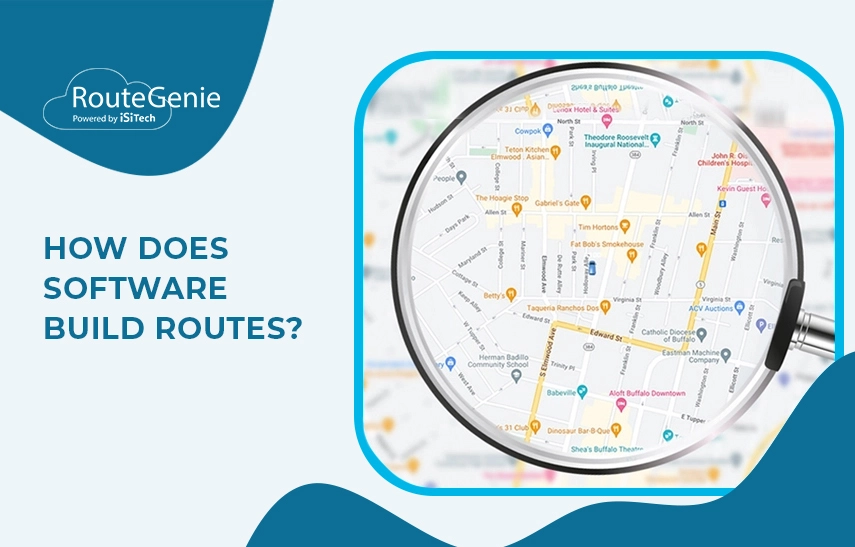How Does Software Build Routes?

Routing and dispatching services are crucial elements of any transportation service. They are used to determine the most efficient route between pickup and drop-off points based on current road conditions and other traffic elements.
Through efficient route planning, vehicles reduce fuel consumption, travel time, and stress on drivers and passengers. It also minimizes the risk of vehicle breakdowns due to extended time on the road.
Contents:
- How Does Software Route Planning Work?
- The Technology Behind Routing Software
- Features in Route Planning Software
- How Route Planning Software Helps Transport Businesses
How Does Software Route Planning Work?
When software processes the schedule and direction of a trip through a public road network, this is called routing. Routing software allows transport companies to create routes within their systems using historical data and real-time data analytics.
One of the most popular free route planners is Google Maps Route Planner. By the way, we created a guide on how to build routes in Google Maps. It has a route planning capability that allows users to get to their desired destination through several options: walking, by car, by public transportation, and even by cycling.
Route optimization software automatically plans the streets that a driver can take to save time and fuel while keeping in mind the business goals of an organization. Real-time traffic and weather analysis are also essential elements that affect the planned route.
The software incorporates GPS to map out the best route to the destination. Current traffic, road repair schedules and restrictions, geologic hazards, and more are also part of the route calculations. It is also crucial to take into consideration the passengers’ preferences and special conditions.
Once all of these elements are analyzed, the software then maps the ideal route that matches all of the required criteria as outlined by the user. It then provides an approximation of the time it will take to complete the trip.
The Technology Behind Routing Software
Several technologies make routing software a very efficient tool in planning your fleet’s route. One of the main assets is a computerized cartography system known as a geographic information system (GIS).
This system uses various data sources, such as aerial photographs, topographic data, and more, to create accurate road maps that can be used for many purposes besides navigation.
For route planning, GIS applications calculate driving times between locations, predict travel times along a particular route, and identify safe alternatives if one option is not ideal. It uses data such as the road network, stops and drop-off points, as well as public transport data to assess traffic volume.
Routing software like RouteGenie also uses route planning algorithms that integrate real-time data, such as traffic, weather, available trips, and the number of passengers.
Once the route software system has collected a database of passengers’ pick-up and drop-off points, special needs, and load times, it can use artificial intelligence and machine learning to plan the most efficient routes that can save time and fuel.
The algorithms involve heuristics and integer programming methods that help the software calculate an optimal route in the shortest possible time and by using vehicles at maximum capacity. The algorithm also includes the software’s business requirements, so vehicle capacity, efficient routes, and on-time performance are all considered.
Features in Route Planning Software

The best route planning software must have several crucial features to ensure that its results will meet business requirements, ensure on-time performance, and meet—or even surpass—customer expectations.
Here are ten critical elements that route planning software needs:
1. Dynamic Routing
Dynamic routing ensures that any vehicle with a set path can easily recalibrate a scheduled trip if there are changes to the schedule or recent traffic developments that will affect the journey.
Software with multi-route capabilities allows fleets to make last-minute changes, like if a passenger develops a sudden emergency and needs medical assistance.
2. Adding Multiple Stops
Some NEMT vehicles carry multiple passengers for one scheduled trip. This means adding several pick-up and drop-off points on the scheduled route. Route planning with multiple stops allows you to plan these types of trips efficiently, giving you a rough estimate of how much time and fuel you will use for the entirety of the journey.
Route planning in Google Maps has this feature. It also allows users to add several stops between the place of origin and the final destination.
3. Rapid Route Optimization
Route planning software should create an optimized route in a matter of seconds. A rapid route optimization feature quickly responds to new metrics and creates the best path that meets your requirements.
4. A Clear and Easy-To-Use UI
Routing apps for drivers, passengers, or even the transport provider’s HR and staff must have an intuitive, clean user interface (UI) that makes it easy for everyone to understand the program and provide a positive experience.
Route planning software with a framework and structure that makes schedules, billing, and management easy to navigate on various devices will make all users happy.
5. Analytics and Reporting
RouteGenie is an excellent NEMT software that has a robust reporting and data analytics system to optimize business operations, improve customer service, and help management make smart, data-driven decisions.
Analytics makes it easy for NEMT business owners to plan their finances, schedule their billing, and assess which trips and customers are helping them earn the most.
6. Customization
Routing software should allow customization to tailor the software to the transportation provider’s needs. This gives them much-needed control over their overall operations.
7. Integration

Broker integration enables routing software to connect to multiple opportunities. So operators and businesses can use one platform for scheduling trips from multiple brokers.
With seamless integration, you can easily access the platform you need within the routing software, saving you time and effort.
8. Fleet Maintenance and Continuous Development
Robust route planning software must have a fleet maintenance system that schedules regular vehicle checkups. It must also have pre and post-trip checklists, to monitor vehicle conditions.
9. Customer Support
Any route planning software with efficient customer service allows businesses and software providers to assess which areas work for their market and which elements of their service need improvement.
Users must have several options to address issues they face while using the software’s features, including scheduling, billing, and even the selection of vehicles and services.
Addressing them properly can go a long way in improving customer relations.
10. Sharing Route Plan Capabilities
Route planning software that can share routes and schedules with passengers, drivers, and facilities can go a long way in creating transparency.
It facilitates information sharing, and all updates by the passenger or the driver can appear instantly on the fleet tracker. This makes it easier to respond to emergencies and makes customers feel more secure whenever they book a trip. Passengers can also easily update family members or healthcare providers about the status of each trip.
How Route Planning Software Helps Transport Businesses
Route planning software like RouteGenie can go a long way in optimizing routes and scheduling trips that will save on time, fuel, and other overhead expenses. At the same time, it gives customers a lot of flexibility in terms of the customization and information-sharing capabilities of good software.
Technology has come a long way to make transport companies this efficient, safe, and profitable. With software like RouteGenie, your transport business can make all of your trips as cost-efficient as possible. Book a demo today!
About the author
An experienced content writer, Keren Dinkin’s forte is writing well-informed medical transportation, healthcare accounting, and related articles. Her work is backed by months of intensive research and pays meticulous attention to details. In addition to being a writer, she also dons the hat of a content strategist.
The author assumes no responsibility or liability for any errors or omissions in the content of this site. The information contained in this site is provided on an "as is" basis with no guarantees of completeness, accuracy, usefulness or timeliness.